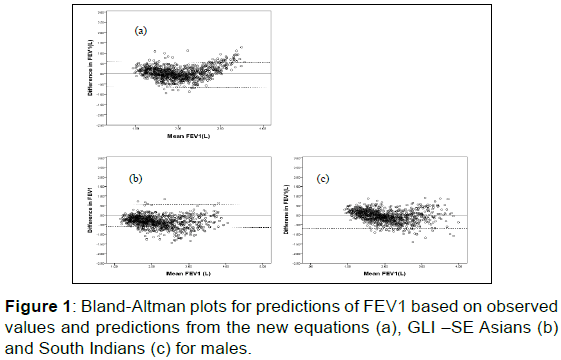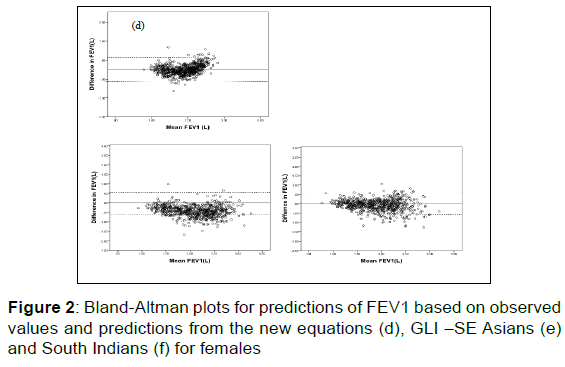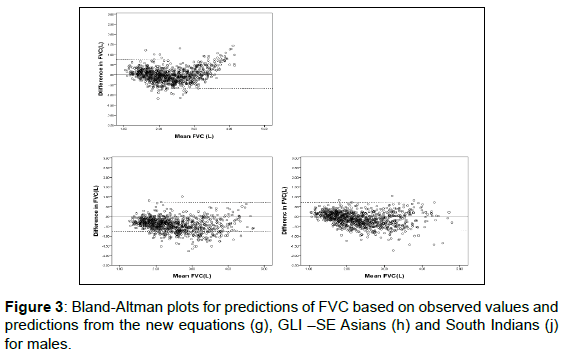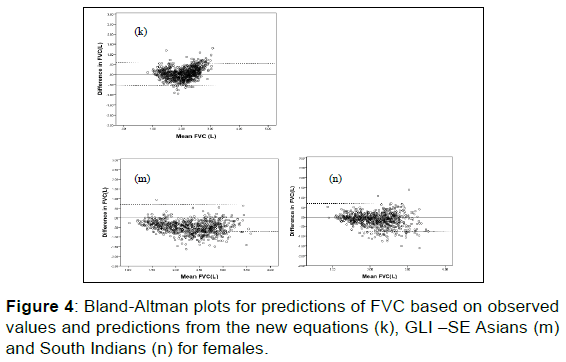Comparison of Different Spirometry Reference Equations in Predicting Lung Function in Sri Lankan School Children
2 National Dengue Control Unit, Ministry of Health, Sri Lanka
3 Professorial Paediatric Unit, Colombo South Teaching Hospital, Sri Lanka
Citation: Liyanage G, et al. Comparison of Different Spirometry Reference Equations in Predicting Lung Function in Sri Lankan School Children. Ann Med Health Sci Res. 2017; 7: 383-387
This open-access article is distributed under the terms of the Creative Commons Attribution Non-Commercial License (CC BY-NC) (http://creativecommons.org/licenses/by-nc/4.0/), which permits reuse, distribution and reproduction of the article, provided that the original work is properly cited and the reuse is restricted to noncommercial purposes. For commercial reuse, contact reprints@pulsus.com
Abstract
Background: In Sri Lanka, for interpretation of spirometry, we often refer South Indian reference values since we do not have normative values for children. Therefore, our aim was to derive Sri Lankan reference values and to compare that with non-Sri Lankan reference equations. Methods: Our reference equations for spirometry for children between 8-16 year olds derived from socio-demographically representative sample “healthy” children. The technique of measurement complied with American Thoracic Society/European Respiratory Society 2005 recommendations. Those were compared with equations of Global Lung Function Initiative 2012 for South East Asians and South Indian values. Results: Measured values of this study are best matched to values from South Indian children. However, values of GLI 2012 are considerably higher than the observed values of the study sample. Conclusions: Observations suggest that reference equations should be derived from the same or comparable populations for which the reference values are to be used.
Keywords
Spirometry; Pulmonary functions tests; Spirometry reference equations; Sri Lankan
Introduction
Spirometry is frequently used as a routine investigation to assess lung function in individuals with respiratory disorders. Nonetheless, it is a useful investigation in research. Interpretation of spirometry results depends on many factors and most importantly presence of appropriate reference values. [1]
There are many spirometry reference values worldwide. They suit for different nationalities, geographic regions and ethnic groups. Third National Health and Nutrition Examination Survey III (NHANES III) in the USA, has published normative standards for Caucasian, African-American and Mexican- American population in the country. [2] In Europe, the European Community for Steel and Coal (ECSC) reference equations are used. [3] Similarly, many other countries/regions all over the world have produced their own reference equations. The recent Global Lung Function Initiative (GLI) study of the European Respiratory Society Task Force, established a global spirometric prediction equations for 3 to 95 year-olds. [4] They derived reference values for four ethnic groups (Caucasian, black, South East Asians-SEA and North East Asians). All the other ethnicities were grouped into “other” category.
For interpretation of spirometry, we often refer South Indian values. [5] However, their suitability for our children has not been analyzed in detail.
Therefore, this study was designed to compare spirometry reference values for healthy Sri Lankan children aged 8-16 years with predictions from GLI 2012-SEA and South India.
Methods
This study generated new reference values for spirometry for children and adolescents aged 8-16 years. Details on the design and enrollment have been published as a communication. [6] Sri Lanka is divided into 25 districts. Districts are well-defined areas with different population sizes into which the entire country is divided for administrative purposes. We clustered the districts into five groups based on the population size in each district. This enabled adequate representation of highly populated areas when sampling was performed.
One district was drawn from each stratum (each group of districts). The variables considered were degree of urbanization, geographic proximity, ethnicity and altitude. Each district has 2-4 educational zones. One educational zone was selected randomly by using lots. Taking one zone minimized the amount of travel necessary in moving from one stand to the next considering geographic proximity of schools. This enabled lessening of the cost on logistic requirements for investigators.
Subsequently all fee- levying and non-fee- levying schools in each educational zone were listed. All schools were stratified according to the type of school with regard to gender. (Girls’/ Boys’/Mixed schools with both boys and girls). Two schools from each group were randomly selected. The sampling rate in each school was designed to include the desired number of sample persons for each age-sex domain.
Data collection
All selected students were invited to take part in the study. They were given questionnaires to take home for their parent/guardian to complete. Questionnaire consisted of three parts. Part 1 was on questions of socio-demographic and family characteristics. Part 2 contained questions based on validated ISAAC questionnaire [7] and questions on acute respiratory illnesses and other chronic disease. Part 3 contained information on exposure to household and environmental risk factors of asthma. The questionnaire was pretested before use.
The school and relevant authorities were given general information about spirometry and a detailed explanation of the procedures involved in the study. Information sheet was provided along with the questionnaire few days prior to the test requesting consent from the parents. Consent was obtained from parent/guardian, and assent was obtained from children more than 12 years. Opportunity was given for any clarifications regarding the study and the procedures involved prior to taking consent.
Completed questionnaires were reviewed. Children with any evidence of previous or concurrent cardio-respiratory disease, very frequent respiratory tract infections, spinal deformity or any other major disease that would affect respiratory functions, upper respiratory tract infections (URTI) like symptoms in the previous 2 weeks and a history of chest, abdominal or nasal surgery were excluded. Only a “healthy” sample of nonsmoking children was taken in to the study.
The Standing height was measured by a stadiometer to the nearest centimeter. The weight was measured without shoes.
Spirometry measurements were recorded with Vitalograph Alpha Touch spirometer which instrument complies with American Thoracic Society/European Respiratory Society 2005 (ATS/ERS). Volume calibration was performed daily by using a 3 liter standard syringe. All technicians received the same training. The measurement protocol fulfilled 2005 American Thoracic Society recommendations.
The test was performed in groups of 4 to 5 students. Others were watching while one student was performing the manoeuvre. That reduced their anxiety of carrying out the procedure and increased the accuracy of the technique. All wore a nose clip and were seated during the procedure. Demonstrations were given and the child was allowed to practice without the equipment. A minimum of 3 and a maximum of 8 manoeuvers were performed to obtain at least two acceptable trials. We adhered to ATS/ERS 2005 criteria for acceptable repeatability of FVC (Forced Vital Capacity) and FEV1 (Forced expiratory volume in one second). From the attempt with the largest sum of FVC and FEV1, other parameters (Peak expiratory flow rate- PEFR and forced expiratory flow between 25% and 75%- FEF 25-75%) were selected.
Statistical analysis
The measured data for variables tested were initially recorded at the sites, double entered, cleaned and were exported to SPSS Version 18 for Windows for statistical analysis. Since the sample derived from different geographic areas and multiple ethnic groups, homogeneity of the sample was tested with Multivariate Analysis of Variance (MANOVA).
Subsequently, the relationship between lung volumes and anthropometric parameters were evaluated. The individual correlations among dependant variables (FVC, FEV1, FEF 25- 75% & PEFR) and independent (predictor) variables (height, weight, age & BMI) were analysed. Predictor variables with a significant correlation were included in multiple regression equations for males and females separately. However, variables that did not improve the predictive ability of the equation were not considered for the final equation. Fitness of the models was decided by the standard error of estimate (SEE), residual analysis (DW statistics) and coefficient of multiple determinations for multiple regressions (R2).
Comparisons were done by computing the mean of individual subject differences between measured values of this study and predicted mean values of other predictions. Bland and Altman plots were also used to investigate the relationship of the discrepancies between the measured/observed values and predicted values derived from non Sri Lankan reference equations. Horizontal line at zero indicates no difference. Values above the zero line indicates that measured values are larger than the predicted values of that particular equation tested.
Results
In total, 2450 underwent spirometry. However, only 1784 were included for final analysis since a large number did not fulfill ‘within maneuover’ criteria for spirometry; poor effort, unsatisfactory exhalation and early termination. Final sample included 73% of the original sample who underwent spirometry. A more detailed description of the participants including age distribution, geographic area and ethnicity is already published as a communication. [6] Information of measured spirometry values and anthropometry are given in Table 1.
| Parameter | Males | Females | ||||||
|---|---|---|---|---|---|---|---|---|
| Mean | SD | Min | Max | Mean | SD | Min | Max | |
| Height in cm | 147.30 | 14.20 | 115 | 186 | 146.20 | 11.77 | 102 | 178 |
| Weight in kg | 36.90 | 12.64 | 17 | 96 | 37.26 | 11.49 | 20 | 86 |
| Body Mass Index (BMI) | 16.65 | 3.62 | 10.25 | 46.65 | 17.10 | 3.65 | 10.37 | 38.95 |
| FVC | 2.32 | 0.71 | 1.06 | 4.82 | 2.06 | 0.51 | 0.88 | 3.73 |
| FEV1 | 2.04 | 0.61 | 0.96 | 4.13 | 1.86 | 0.45 | 0.78 | 3.08 |
| FEV1/FVC | 88.18 | 5.29 | 66 | 100 | 90.42 | 5.83 | 60.40 | 106 |
| FEF 25-75% | 2.52 | 0.83 | 0.86 | 5.74 | 2.48 | 0.71 | 0.67 | 4.47 |
| PEFR | 4.35 | 1.42 | 1.35 | 9.48 | 3.82 | 1.09 | 1.19 | 7.30 |
Table 1: Descriptive statistics of anthropometry and spirometry parameters of the study sample.
Results of MANOVA analysis is presented as supplementary material (S1 & S2). It confirmed that sample is homogenous and the equations obtained could be generalized among ethnic groups and geographic regions.
Deriving the equations
Predictor variables considered for inclusion in the models were age, standing height and weight. BMI is a derivative both weight and height and therefore, it was not considered to be included in the equations. In developing a model, age is anyway a required variable in interpreting spirometry. Among all anthropometric parameters standing height showed the best correlation.
Regression analysis of spirometry parameters with age and height were performed with different transformations (square root, log, squared, cubed). Subsequently we compared models of transformed and untransformed forms of equations. We decided to adhere to the untransformed form of the equations since we did not see a significant improvement of R2 values. Further, in our study, respiratory volumes and flows of males showed an upward deviation with puberty. However, in females it was a linear smooth curve. Therefore, we examined whether equations for males in particular will need further refinement. Thus, piecewise regression was applied. Yet, there was no improvement in precision of the equations.
The residual analysis of the equations was performed visually by P-P plot and histogram for model adequacy. Further assessment was carried-out using Dubin-Watson statistics. The estimated coefficient associated with independent variables (FVC, FEV1, FEF 25-75%, PEFR and FEV1/FVC are shown in Table 2. The R2 value for FEV1/FVC ratio was low and it indicates that age and height do not seem to explain the variability of FEV1/FVC ratio adequately.
| FVC | FEV1 | FEF 25-75% | PEFR | FEV1/FVC | |
|---|---|---|---|---|---|
| Males | |||||
| Constant | -3.889 | -3.210 | -2.619 | -5.515 | 0.965 |
| Age | 0.066 | 0.067 | 0.099 | 0.252 | 0.002 |
| Height | 0.035 | 0.028 | 0.023 | 0.040 | -0.001 |
| R2 value | 78.4 | 78 | 52 | 61.1 | 1.8 |
| Lower limit of normal (LLN) for height | 0,037 | 0.028 | 0.027 | 0.047 | - |
| Females | |||||
| Constant | -2.625 | -2.227 | -2.205 | -2.968 | 0.970 |
| Age | 0.071 | 0.062 | 0.096 | 0.203 | 0.000 |
| Height | 0.026 | 0.023 | 0.024 | 0.023 | 0.000 |
| R2 value | 68 | 68.3 | 41.5 | 43.3 | 0.9 |
| Lower limit of normal (LLN) for height | 0.024 | 0.021 | 0.020 | 0.023 | - |
Table 2: Estimated co-efficient associated with independent variables for spirometry indices for two genders.
Comparison of baseline characteristics of study populations
Characteristics (age, sex etc) of all three populations were compared [Table 3]. GLI-South-East Asian equations had been derived from subjects from South China, Thailand and Taiwan. We used Alpha Touch Vitalograph spirometer whereas to derive South Indian equations, a dry rolling spirometer (Transfer Test model C, P.K. Morgan Ltd. U.K) had been used.
| Study | Centre/s | Data collection | No. of healthy subjects | Age range (y) | Boys (%) |
|---|---|---|---|---|---|
| GLI- SEA | China, Thailand, Taiwan | 1996-2002 | 8255 | 3.2-92 | 37.4 |
| South Indian | South India | 1999-2000 | 469 | 9-16 | 52.4 |
| This study | Sri Lanka | 2013-2015 | 1784 | 8-16 | 54.0 |
Table 3: Comparison of baseline characteristics of study populations.
Comparison of spirometry equations
We calculated the mean of individual subject differences between measured values and predicted mean values from our study, GLI 2012 for South East Asians and South Indians [Table 4]. Bland and Altman curves are shown in Figures 1- 4 to show the visual differences. Measured values were compatible with predicted values of equation for South Indian males and females. However, predicted values from GLI 2012-SEA equations are higher than the measured values that were obtained in this study.
| Parameters | Study | Males | Females | ||||
|---|---|---|---|---|---|---|---|
| Mean of individual subject difference % |
Absolute difference (Liters) | Z Score | Mean of individual subject difference % |
Absolute difference (Liters) | Z Score | ||
| FVC | GLI (SE Asian) | -16.792 | -0.326 | -0.475 | -21.443 | -0.371 | -0.786 |
| South Indian | 1.967 | 0.061 | 0.061 | 3.326 | 0.159 | 0.290 | |
| FEV1 | GLI (SE Asian) | -19.880 | -0.316 | -0.557 | -14.263 | -0.229 | -0.563 |
| South Indian | 2.385 | 0.038 | 0.038 | 3.655 | 0.020 | 0.043 | |
| FEF 25-75% | GLI (SE Asian) | 4.865 | 0.106 | 0.212 | 7.184 | 7.184 | 0.421 |
| South Indian | - | - | - | - | - | - | |
Table 4: Comparison of predicted means of this study GLI 2012-SEA and South Indian values with observed means.
Discussion
We included healthy children without chronic cardiac or respiratory diseases. Further, children with recent history of acute respiratory illnesses were excluded. The selected group of children was from a socio-demographically representative population. Age, gender, geographic area and ethnicity are some of the attributes that were considered in the selection of the sample.
We chose multiple linear regression models to obtain equations.
We compared the new equations of this study with those of GLI 2012 for South East Asians and South Indian. These non- Sri Lankan equations were chosen for comparisons, among several others for certain reasons. South Indian equations are the most commonly used for spirometry interpretation in Sri Lanka. GLI 2012 study was designed for number of ethnic groups which is valid across the ages of 3-95 years. It had reviewed data from more than 74,000 healthy nonsmokers across the world. Yet, they have not included data from Indian subcontinent. However, we considered South East Asian equations of GLI 2012 for comparison since they are the closest to us geographically.
Similarities were found in measured values of the present study and predicted means of South Indian males and females. Maximum mean difference noted was 140ml for FVC in females. Reason for fewer differences between means of Indian predictions and observed means of our study could have been due to similarities in body physics and similar geographic areas.
Our predicted means for FVC, FEV1, PEFR and FEF 25-75% for both females and males are poorly matched to predictions from GLI 2012 for South East Asians. Non-inclusion of data from the Indian subcontinent could be the principle reason for this discrepancy. However, we did not expect this degree of a disagreement between our values and GLI 2012 for South East Asian values. Refining GLI 2012 further with inclusion of data from Indian subcontinent may lessen this difference.
It is clear that GLI 2012 for South East Asians cannot be used to interpret spirometry in children of this age group in Sri Lanka. These equations are derived from populations that are different in age, height and body proportions. However, age and height were accounted for when the models were formed. Body proportions, chest size, and muscle mass could be other factors that are responsible for the difference between predictions. In addition, type of cohort (eg cross sectional or longitudinal samples), ethnicity, altitude and equipment used may also have contributed. Therefore, it is evident that normative values for spirometry should be population specific and interpretation of spirometry using other non Sri Lankan references could lead to errors.
Conclusion
The differences in predicted spirometry parameters derived from our study compared to values obtained from other studies emphasizes the importance of using appropriate reference values relevant to the local population, in diagnosis and follow up of patients with respiratory diseases. Predictions based on models established elsewhere may not be appropriate to assess lung conditions appropriate to local population. The reference values established in this study will be applicable for use in all ethnic groups and all geographic regions, including highlands in Sri Lanka.
Acknowledgement
The authors would like to acknowledge Technical Officer: Asitha Weerasinghe, Medical Officers: Q. Jayah & Dr Lakkhana Senevirathne at Department of Paediatrics, Faculty of Medical Sciences, University of Sri Jayewardenepura, Dr.E.P.D.S.Ediriweera from University of Kelaniya and .J.S.N.P.Dharmawardena from Department of Census and Statistics, Sri Lanka
Conflict of Interest
All authors disclose that there was no conflict of interest.
REFERENCES
- Miller MR, Hankinson J, Brusasco V, Burgos F, Casaburi R, Coates A, et al. Standardization of spirometry. Eur Respir J. 2005; 26: 319-338.
- Hankinson JL, Odencrantz JR, Fedan KB. Spirometric reference values from a sample of the general U.S. population. Am J RespirCrit Care Med. 1999; 159: 179-187.
- Quanjer PH, Tammeling GJ, Cotes JE, Pedersen OF, Peslin R, Yernault JC. Lung volumes and forced ventilatory flows. Report Working Party Standardization of Lung Function Tests, European Community for Steel and Coal. Official Statement of the European Respiratory Society. Eur Respir J Suppl. 1993; 16: 5-40.
- Quanjer PH, Stanojevic S, Cole TJ. Multi-ethnic reference values for spirometry for the 3–95-yr age range:the global lung function 2012 equations. Eur Respir J. 2012; 40: 1324-1343.
- Vijayan VK, Reetha AM, Kuppurao KV, Venkatesan P, Thilakavathy S. Pulmonary function in normal South Indian children aged 7 to 19 years. Indian J Chest Dis Allied Sci. 2000; 42: 147-156.
- Liyanage G. De Silva CC. Spirometry in children: Meeting the unmet need. Sri Lanka. Journal of Child Health, 2016; 45: 151-162.
- Solé D, Yamada E, Vana AT, Werneck G, Solano de Freitas L, Sologuren MJ, et al. International study of asthma and allergies in childhood (ISAAC): Prevalence of asthma and asthma-related symptoms among Brazilian schoolchildren. J Investig Allergol Clin Immunol. 2001; 11(2):123-128.








 The Annals of Medical and Health Sciences Research is a monthly multidisciplinary medical journal.
The Annals of Medical and Health Sciences Research is a monthly multidisciplinary medical journal.